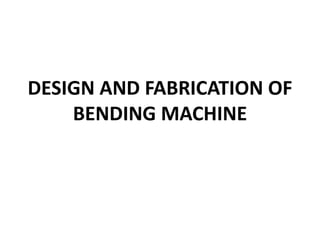
Design and fabrication of bending machine
- 1. DESIGN AND FABRICATION OF BENDING MACHINE
- 2. ABSTRACT • My project is to design and construct a bending machine. This machine is used to bend steel into curve or other curvature shape. The size of the machine is very convenient for portable work. It is fully made by steel. Moreover it is easy to be carried and used at any time and any place.
- 3. INTRODUCTION • To build this machine many equipment or machine is used. By using all this equipment, process for making the project is faster and easier. I had also learned a proper method for operating all this machine and equipment. Choosing component material is very important, because it will affect the overall cost of the machine and the product quality. With this consideration, I had design this machine with the maximum quality and low in cost.
- 4. TYPE OF BENDING MACHINES • TUBE BENDING • CIRCLE BENDING • BAR BENDING • CHENNEL BENDING • SQUARE BENDING
- 5. TUBE BENDING: The Forming Roller method of tube bending is recommended for all large bends. where the centerline radius is at least 4 times the outside diameter of the tube. It can also be successfully employed for bending pipe or heavy wall tubing to smaller radii and is the most practical method of bending very small diameter tubing. The Forming Roller and Radius Collar must be grooved to exactly fit the tube and the tube must not be allowed to slip during the bending operation as even a slight amount of slippage will cause distortion.
- 7. CIRCLE BENDING: This operation is somewhat involved by the fact that most materials “spring back” after they have been formed. To compensate for this, it is often necessary to use a Radius Collar having a smaller diameter than that of the circle required. Actual size can best be determined by experiment, as the “spring back” varies in different materials. Material should be precut to exact length before forming.
- 9. • CHANNEL BENDING: The same general bending rules which cover the forming of channel with “flanges out” also apply when it is formed with “flanges in.” Since it is necessary to compress the flanges as they are bent inward, the operation shown below requires considerably more bending pressure than when forming with the “flanges out”, and it is recommended that the largest possible radius be used to allow for compression of the material. if a sharp 90 bend is desired, it can be obtained by cutting a notch out of the channel flanges before forming around a special Zero Radius Block as illustrated . It is sometimes possible to make a circle in channel by using a segment of a Radius Collar similar . By following the procedure outlined on, the circle can be formed in three operations. To form channel with the flanges facing upward it is necessary to first fill it with Cerro bend or some other commercial filler as it is not possible to support the flanges in this position with a radius Collar.
- 11. • SQUARE BENDING: Forming zero radius bends around square, rectangular, or other multisided blocks employs the same principle used in scroll bending. Forming Nose “leads” material between corners of the block. Any number of zero radius bends can be obtained in one operation by this method in all types of solid materials. Both centered and off-center square eye can also be formed by following the same procedure outlined on. This method of bending is limited by the size of the square block and the ductility of the material. In general, when squares larger than 1” are needed, they should be formed in progressive operations using the zero radius block.
- 13. WORKING
- 14. WORKING The rod to be bent is placed in between the two Jigs mounted on the circular plate. The motor is attached with the circular plate. The power from the motor is transfered which rotates the circular plate in anticlockwise direction.one Jig is connected to the motor and the other Jig is rotated due to the rotation of circular plate. The rod will be fixed since the fixed rod lies on the other side . since the rod is kept in between the two Jigs, the rod would bent.
- 15. CALCULATION
- 16. calculated shear stress τ = 458 N/mm2 wkt , (σb÷y) = (Mt÷I) y = (d÷2) = (10÷2) = 5mm moment of inertia I = (π÷64)×d4 I = (π÷64)×104 = 490.87 mm4 σb= 89×103×5/490.87 bending stress σb = 906.66 N/mm2 substitute all the values in the above relation.
- 17. 906.66/10 = M/490.87 M = 44500 N mm WL/4= 44500 W = 44500×4/100 L = length of the rod = 200 mm W = 1780 N =182 kg Polar moment of Twist J = (π÷32)d4 = (π÷32) ×104 J = 981.74 mm4 Common angle of Twist Θ = (T×L÷Cs×J) Cs = modulus of rigidity = 8.4×104 N/mm2 Θ = (90×103×100/8.4×104×981.74) Θ = 0.109 rad Θ = 0.109×(180÷π) Θ = 6.25°
- 18. APPLICATIONS • ANGLE BENDING • METAL FOLDING • U HOOK • MARINE TUBE • HEAT EXCHANGER • SCROLL BENDING
- 19. ADVANTAGES • Easily operated. • Simple construction. • Low cost.
- 20. SPECIFICATION MOTOR • MOTOR POWER -0.5hp • SPEED -40rpm CIRCULAR DISC • DIAMETER -20mm • THICKNESS -2.5mm jigs -2 no BATTERY -12v